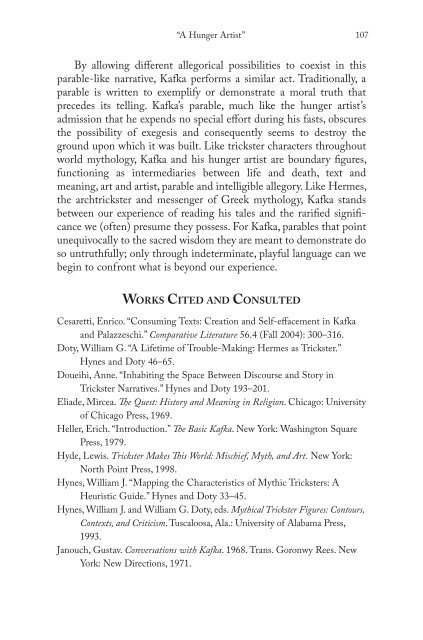Blooms Literary Themes - THE TRICKSTER.pdf - ymerleksi - home
Blooms Literary Themes - THE TRICKSTER.pdf - ymerleksi - home
Blooms Literary Themes - THE TRICKSTER.pdf - ymerleksi - home
Create successful ePaper yourself
Turn your PDF publications into a flip-book with our unique Google optimized e-Paper software.
“A Hunger Artist” 107<br />
By allowing diff erent allegorical possibilities to coexist in this<br />
parable-like narrative, Kafka performs a similar act. Traditionally, a<br />
parable is written to exemplify or demonstrate a moral truth that<br />
precedes its telling. Kafka’s parable, much like the hunger artist’s<br />
admission that he expends no special eff ort during his fasts, obscures<br />
the possibility of exegesis and consequently seems to destroy the<br />
ground upon which it was built. Like trickster characters throughout<br />
world mythology, Kafka and his hunger artist are boundary fi gures,<br />
functioning as intermediaries between life and death, text and<br />
meaning, art and artist, parable and intelligible allegory. Like Hermes,<br />
the archtrickster and messenger of Greek mythology, Kafka stands<br />
between our experience of reading his tales and the rarifi ed signifi -<br />
cance we (often) presume they possess. For Kafka, parables that point<br />
unequivocally to the sacred wisdom they are meant to demonstrate do<br />
so untruthfully; only through indeterminate, playful language can we<br />
begin to confront what is beyond our experience.<br />
WORKS CITED AND CONSULTED<br />
Cesaretti, Enrico. “Consuming Texts: Creation and Self-eff acement in Kafka<br />
and Palazzeschi.” Comparative Literature 56.4 (Fall 2004): 300–316.<br />
Doty, William G. “A Lifetime of Trouble-Making: Hermes as Trickster.”<br />
Hynes and Doty 46–65.<br />
Doueihi, Anne. “Inhabiting the Space Between Discourse and Story in<br />
Trickster Narratives.” Hynes and Doty 193–201.<br />
Eliade, Mircea. Th e Quest: History and Meaning in Religion. Chicago: University<br />
of Chicago Press, 1969.<br />
Heller, Erich. “Introduction.” Th e Basic Kafka. New York: Washington Square<br />
Press, 1979.<br />
Hyde, Lewis. Trickster Makes Th is World: Mischief, Myth, and Art. New York:<br />
North Point Press, 1998.<br />
Hynes, William J. “Mapping the Characteristics of Mythic Tricksters: A<br />
Heuristic Guide.” Hynes and Doty 33–45.<br />
Hynes, William J. and William G. Doty, eds. Mythical Trickster Figures: Contours,<br />
Contexts, and Criticism. Tuscaloosa, Ala.: University of Alabama Press,<br />
1993.<br />
Janouch, Gustav. Conversations with Kafka. 1968. Trans. Goronwy Rees. New<br />
York: New Directions, 1971.

















